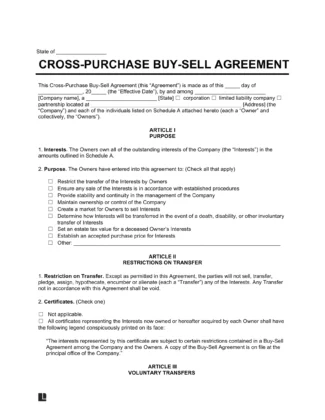Cross-Purchase Buy-Sell Agreement Template

A Cross-Purchase Buy-Sell Agreement is a legal document that outlines what happens to a person’s equity or interests in a company when that person retires, dies, or becomes incapacitated. This type of agreement is frequently involved in business continuity planning and is critical if a company has multiple owners.
The document usually outlines how the remaining partners can divide or purchase the interests in the event of one of the owners’s death, retirement, or incapacitation. With a cross-purchase buy-sell agreement in place, the business can minimize disruption and ensure that all equity in the company is divided fairly.
- When to Use a Cross-Purchase Buy-Sell Agreement
- How Cross-Purchase Buy-Sell Agreements Work
- What To Include
- Cross-Purchase Buy-Sell Agreement Sample
When to Use a Cross-Purchase Buy-Sell Agreement
If you have a company with only a few partners, it could be beneficial to have a cross-purchase agreement. In this case, a cross-purchase-buy-sell agreement life insurance policy should be considered, with the other partners listed as beneficiaries. This is because, in case of the death of one of the partners, the proceeds from the life insurance policy can be used to purchase that partner’s interests. However, if you have a business with multiple partners, each partner might have their own life insurance policy that protects the others. This can make the agreement a bit complicated.
That is why it is helpful to take a look at a cross-purchase buy-sell agreement example that has more than two partners. For example, you might even need to take out a cross-purchase buy-sell agreement with three partners. When there are more than two partners, the structure may have to change slightly, and a template can be helpful.
How Cross-Purchase Buy-Sell Agreements Work
Here’s a step-by-step guide on how Cross-Purchase Buy-Sell Agreements work in practice:
- Identify the triggering events: Specify the triggering events that will activate the buy-sell provisions. These events typically include the death, retirement, or incapacitation of a business partner.
- Determine the value of the interests: Specify how the interests of the departing partner will be valued. This can be done through an independent valuation or by using a predetermined formula that is agreed upon by all partners.
- Arrange for life and disability insurance: To fund the buyout, partners should take out life and disability insurance policies on one another. If a partner dies or becomes incapacitated, the insurance payout can be used to purchase the departing partner’s interests.
- Establish a purchase price: Establish a purchase price for the departing partner’s interests. This can be done using a formula or through negotiation between the remaining partners.
- Offer the interests to remaining partners: If a partner retires, becomes incapacitated, or passes away, the remaining partners have the first right to purchase that partner’s interests.
- Sell the interests: If the remaining partners choose not to purchase the departing partner’s interests, the interests can be sold to an outside buyer or back to the company.
What To Include
If you want to write a cross-purchase buy-sell agreement, there are several important elements you need to include. A few examples are:
- Buyout Events: You need to include specific triggers for a potential buyout event. A few examples include the death of a business partner, the retirement of a business partner, or having a business partner who becomes incapacitated.
- Valuation: You also need to specify the valuation of the person’s interests. If that person triggers one of the events above, how much money is required to buy out all of the interest that person has? When writing this agreement, the partners need to agree on the value of the business.
- Life Insurance: When you write this agreement, you must have partners take out a life insurance policy on each other. That way, if someone passes away, a life insurance benefit can be used to purchase that person’s interests. You may also want to reach out to an accountant to talk about the potential income tax implications of life insurance.
- Disability Insurance: If someone becomes incapacitated, but they do not pass away, a life insurance payout may not be triggered. In this case, disability insurance could be used to purchase interests from that individual. It is not unusual for disability insurance to be paid out in installments, so you need to think carefully about how to structure your disability insurance benefit.
Because these agreements can be complicated, it is helpful to reach out to an attorney who can walk you through the process. You need to consider potential pitfalls, drawbacks, and obstacles that could make it harder for you to ensure the continuity of your business.
If you work with an attorney, you can anticipate a lot of these problems ahead of time. Then, you can streamline your business’s transition if any of the events above are triggered.
Cross-Purchase Buy-Sell Agreement Sample
Below, you can download a cross-purchase buy-sell agreement in PDF or Word format:


